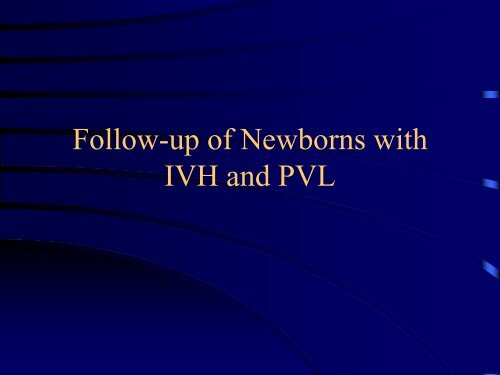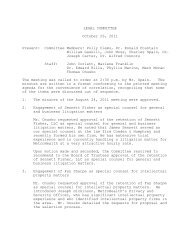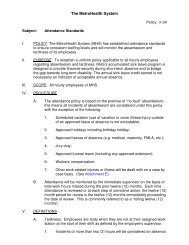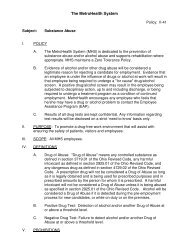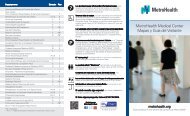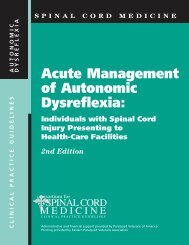FollowUp of Newborns with IVH and PVL - The MetroHealth System
FollowUp of Newborns with IVH and PVL - The MetroHealth System
FollowUp of Newborns with IVH and PVL - The MetroHealth System
Create successful ePaper yourself
Turn your PDF publications into a flip-book with our unique Google optimized e-Paper software.
Follow-up <strong>of</strong> <strong>Newborns</strong> <strong>with</strong><br />
<strong>IVH</strong> <strong>and</strong> <strong>PVL</strong>
Incidence <strong>of</strong> <strong>IVH</strong>/<strong>PVL</strong><br />
• Declining <strong>IVH</strong> rates<br />
• Increasing <strong>PVL</strong> rates<br />
• Impact <strong>of</strong> changing survival rates<br />
• What is the denominator?<br />
• Ultrasound v. CT/MRI
<strong>IVH</strong> Incidence<br />
Declining secondary to ?-<br />
• Aggressive resuscitation, esp. for ELBW’s<br />
• Improved ventilation techniques<br />
• Exogenous surfactants<br />
• Prompt, cautious CV support<br />
• Aggressive OB management-c/s, steroids
• VLBW (
• Papile:<br />
Classification <strong>System</strong>s<br />
Grade 1-subependymal germinal matrix<br />
Grade 2-<strong>IVH</strong> w/o ventricular dilatation<br />
Grade 3-<strong>IVH</strong> w/ ventricular dilatation<br />
Grade 4-additional parenchymal<br />
hemorrhage
Classification <strong>System</strong>s<br />
• Levene:<br />
Grade 1-subependymal hemorrhage<br />
Grade 2-<strong>IVH</strong> in < 50% <strong>of</strong> lat. ventricles<br />
Grade 3-<strong>IVH</strong> in > 50% <strong>of</strong> lat. ventricles
CNS Development<br />
• Neurons- formed by completion <strong>of</strong> second<br />
trimester<br />
• Neuronal migration- accomplished by both<br />
passive migration <strong>and</strong> via radial glial<br />
‘guide’<br />
- takes < 3 days early on<br />
- takes 1-3 weeks later in gestation
CNS Development<br />
• Cerebral organization- neurons reach final<br />
destination, develop dendrites, axons, <strong>and</strong><br />
connect to other neurons.<br />
• Astrocytes <strong>and</strong> oligodendroglia- ‘born’<br />
during third trimester; form ‘skeletal’<br />
framework <strong>of</strong> brain <strong>and</strong> produce myelin.
CNS Development<br />
• Myelogenesis- lipid sheath formed from<br />
oligodendroglial contact to axon; allows<br />
higher velocity <strong>of</strong> electrical impulses.<br />
• Begins later in third trimester; very active at<br />
term; continues through adolescence;<br />
requires appropriate cell numbers <strong>and</strong> cell<br />
contacts; requires FA’s, PL’s, cholesterol,<br />
gangliosides-- so, nutritional status is<br />
important.
CNS Development<br />
• Substantial evidence for specificity <strong>of</strong><br />
inputs during sensitive periods <strong>of</strong> brain<br />
development to support normal cortical<br />
ontogenesis; Example-Amblyopia.<br />
• Concept <strong>of</strong> Plasticity-animal models.
• Confounders<br />
Outcome Issues<br />
-SES<br />
- Degree <strong>of</strong> medical illness<br />
- Birth weight<br />
- Gestational age<br />
- Other - cocaine
• Length <strong>of</strong> follow-up<br />
• ‘Lost’ patients<br />
Outcome Issues
Outcome Issues<br />
• Methods <strong>of</strong> follow-up<br />
• Testing modalities-are they comparable?<br />
• Physical exam?
• Controls<br />
- historical<br />
• Comparison Groups<br />
- peers<br />
-siblings<br />
Outcome Issues
• Length <strong>of</strong> follow-up<br />
• Size <strong>of</strong> study<br />
<strong>IVH</strong> Studies<br />
- hospital<br />
- regional<br />
-multi-center<br />
• Subset <strong>of</strong> ELBW/VLBW studies
<strong>IVH</strong>-Short Term Outcomes<br />
• Papile, New Mexico,1983<br />
•
<strong>IVH</strong>-Short Term Outcomes<br />
• Sostek, Georgetown, 1987<br />
• Good prediction between 1 yr <strong>and</strong> 2 yr<br />
scores, but not from neonatal risk.<br />
• <strong>IVH</strong> constitutes only a limited, imperfect<br />
model <strong>of</strong> risk status.<br />
• Grade 1-2 <strong>IVH</strong>= No <strong>IVH</strong>
<strong>IVH</strong>-Short Term Outcomes<br />
• Ross, Cornell, 1996<br />
• Grade 1-2’s worse on Piaget’s invisible<br />
location task (memory for location) v.<br />
preterm <strong>and</strong> full term controls at 2 yrs.
<strong>IVH</strong>-Short Term Outcomes<br />
• Morales, 1987; Follow-up: ONE year<br />
• No <strong>IVH</strong>>Gr.1-2>Gr.3>Gr.4 on mental <strong>and</strong><br />
motor scores, <strong>and</strong> neuro h<strong>and</strong>icaps.<br />
• Mental: 96.5 (no <strong>IVH</strong>) v. 90.1(Gr.1-2)<br />
• Motor: 95.5(no <strong>IVH</strong>) v. 86.7(Gr. 1-2)<br />
• Neuro: 7%(no <strong>IVH</strong>) v. 11.5%(Gr.1-2)
<strong>IVH</strong>-Short Term Outcomes<br />
• Vohr <strong>and</strong> Garcia Coll, Brown, 1989<br />
• Grade 3-4 (n=34) w/ worse mental <strong>and</strong><br />
motor scores, worse eye-h<strong>and</strong> coordination,<br />
object manipulation, object relations (visual<br />
motor coordination) than preterm <strong>and</strong> full<br />
term controls at 2 yrs.
<strong>IVH</strong>-Short Term Outcomes<br />
• Blackman, Iowa, 1991<br />
• 16 Grade 4 <strong>IVH</strong>’s ; follow-up-33 mo.<br />
-5/16, DQ>83<br />
- 9/16, DQ= 52-83<br />
-2/16, DQ
<strong>IVH</strong>-Short Term Outcomes<br />
• Bendersky, Robert Wood Johnson,1995<br />
• 105 preterms; follow-up - 3 yrs.<br />
- Grade 3-4--worse in gross motor,<br />
receptive <strong>and</strong> expressive language.<br />
- Grade 1-2--no different than controls.
<strong>IVH</strong>-Short Term Outcomes<br />
• Aziz, Alberta, 1995; Follow-up: 3 yrs.<br />
• 646 survivors, 500-1250 grams<br />
- Grade 2 <strong>IVH</strong>- 0/16 abnormal<br />
- Grade 3 <strong>IVH</strong>, IPE, +/or CV-29/63 (46%)<br />
abnormal.<br />
- Grade 4 <strong>IVH</strong>-12/14(86%) abnormal.
<strong>IVH</strong>-Short Term Outcomes<br />
• Wilson-Costello, RB&C,1998<br />
•
<strong>IVH</strong>-Long Term Outcomes<br />
• Msall, Buffalo, 1991<br />
• 75 surviving 24-28 wks, 1983-84 cohort.<br />
- 19/75 w/ major impairments (9MR, 4CP,<br />
1 blind, 5 multiply h<strong>and</strong>icapped).<br />
- 71/75-functionally independent<br />
- CP rel. risk= 5.8 for Grade 3-4<br />
- MR rel. risk=5.4 for hydoceph (not <strong>IVH</strong>)
<strong>IVH</strong>-Long Term Outcomes<br />
• Vohr <strong>and</strong> Garcia Coll, Brown, 1992<br />
•
<strong>IVH</strong>-Long Term Outcomes<br />
• Piecuch,UCSF, 1997-446 infants, 500-1000<br />
grams, 1979-91; follow-up-55 mo(+/- 33)<br />
- 61% normal survival<br />
- 59 w/ Gr.3-4 <strong>IVH</strong> or <strong>PVL</strong><br />
- 22/59 (37%)-mod/severe neuro abnormal<br />
- 5/59 (9%)-mildly abnormal<br />
- 32/59 (54%)- normal
<strong>IVH</strong>-Long Term Outcomes<br />
• Kilbride, U. <strong>of</strong> Missouri, 1998<br />
• 1983-85 <strong>and</strong> 1986-89,
<strong>IVH</strong>-Other Follow-up Issues<br />
• Christiansen, Little Rock, 1997<br />
•
<strong>IVH</strong>-Other Follow-up Issues<br />
• King <strong>and</strong> Cronin, Loyola-Chicago, 1993<br />
• 13 infants w/ Gr. 4 <strong>IVH</strong> <strong>and</strong> 11 GA <strong>and</strong> BW<br />
matched controls.<br />
- 12/13 <strong>IVH</strong> v. 8/11 controls w/ ocular<br />
abnormalities<br />
- 5/13 <strong>IVH</strong> v. 0/11 controls w/ visual loss<br />
(optic atrophy <strong>and</strong> ROP).
<strong>IVH</strong>-Hydrocephalus<br />
• Resch, 1996-299 <strong>IVH</strong>’s, 1984-1988 cohort<br />
• Follow-up: 5 yrs<br />
• 68 w/ hydrocephalus (23 died, 5 lost)<br />
10/40-normal<br />
10/40-mild neuro symptoms<br />
11/40-mod h<strong>and</strong>icaps +/or mod MR<br />
9/40-severe h<strong>and</strong>icaps +/or severe MR
• Associations:<br />
– Tocolysis<br />
– PDA<br />
– Hypotension<br />
– Hypocapnea<br />
– HFOV<br />
– Chorioamnionitis<br />
<strong>PVL</strong><br />
– Early neonatal dexamethasone Rx
<strong>PVL</strong>-Etiology<br />
• Hypotension/ischemia<br />
• Impaired cerebral autoregulation<br />
• Oligodendroglial cell death due to free<br />
radical scavengers
<strong>PVL</strong><br />
• Final etiologic pathway: maturation-<br />
dependent vulnerability <strong>of</strong> oligodendroglial<br />
precursor cell, (major cellular target in<br />
<strong>PVL</strong>)<br />
– cells vulnerable to attack by free radicals,<br />
generated in abundance during ischemia -<br />
reperfusion.
<strong>PVL</strong><br />
• Chorioamnionitis associated w/ persistent<br />
inflammatory reaction at site <strong>of</strong> <strong>PVL</strong><br />
• High expression <strong>of</strong> cytokines, especially<br />
TNFalpha <strong>and</strong> also interleukin - 1 beta
<strong>PVL</strong><br />
• Antenatal steroids - Protective ?<br />
(> 50% reduction)
<strong>PVL</strong><br />
• Cystic <strong>PVL</strong> (large v. small cysts)<br />
• Thinning PV white matter<br />
• Transient periventricular echodensities<br />
• Persistent periventricular echodensities<br />
• ‘Flares’
<strong>PVL</strong>-Echodensities<br />
• Bleeding into an ischemic area<br />
• Venous infarction
<strong>PVL</strong> Outcomes<br />
• deVries, Netherl<strong>and</strong>s, 1993-504 infants,
<strong>PVL</strong> Outcomes<br />
• Ringelberg, Netherl<strong>and</strong>s, 1993- 353 infants<br />
• Fazzi, Italy, 1994<br />
<strong>PVL</strong> Outcomes<br />
• 37 c<strong>PVL</strong>’s; follow-up, 5-7 yrs.<br />
- Small cysts: 2/11 w/ CP, 1/11 w/ MR, 7/11<br />
w/ mild neuro signs, 1/11 normal.<br />
- Large cysts:14/14 w/ CP.<br />
- Prolonged flare: 6/12 w/ CP, 4/12 w/ mild<br />
neuro signs, 2/12 normal.
<strong>PVL</strong> Outcomes<br />
• Rogers <strong>and</strong> Msall, Buffalo, 1994<br />
• 31 c<strong>PVL</strong>’s w/ 26 survivors; follow-up, 21.5<br />
mo, (range, 9-51 mo).<br />
- 26/26 w/ CP--54%quad,42%di,4% hemi.<br />
- 18/25 w/ MR<br />
- 14/14 quads w/ MR.<br />
- Bigger <strong>and</strong> more cysts seen w/ quad.
<strong>PVL</strong> Outcomes<br />
• Wilkinson, Australia, 1996<br />
• 12 severe c<strong>PVL</strong>’s; follow-up, 27.3 months.<br />
• 10/10 survivors w/ spastic quad <strong>and</strong> visual<br />
impairments.
<strong>PVL</strong> Outcomes<br />
• Rogers <strong>and</strong> Msall, Buffalo, 1998<br />
• 41 c<strong>PVL</strong>’s<br />
- 39/41 w/ CP<br />
- 18/41 w/ growth failure due to oral<br />
feeding impairment.
<strong>PVL</strong><br />
• Japan: Diplegia (72/81 <strong>PVL</strong>); Quadriplegia<br />
(12/45 <strong>PVL</strong>)<br />
• Japan: <strong>PVL</strong> most common etiology w/<br />
spastic diplegia in premies<br />
• Italy: 30 preterm spastic diplegic, all w/<br />
<strong>PVL</strong>
<strong>PVL</strong><br />
• Visual impairment prominent<br />
• Italy = 23/38 <strong>PVL</strong>’s w/ visual impairment<br />
(9 blind; 14 w/ low acuity) ; associated w/<br />
decreased peritrigonal white matter<br />
• Italy: 21/29 <strong>PVL</strong>’s w/ some visual function<br />
abnormality; correlated highly w/<br />
neurodevelopmental scores
<strong>PVL</strong><br />
• Sweden: 18 visually impaired children; 10<br />
w/ <strong>PVL</strong> affecting optic radiation per MRI<br />
• Sweden: 16/19 <strong>PVL</strong>’s w/ horizontal<br />
nystagmus; most w/ optic nerve hypoplasia<br />
• Netherl<strong>and</strong>s: <strong>PVL</strong> most associated w/<br />
visual-perceptual disabilities (no <strong>IVH</strong><br />
association)
• Other associations:<br />
<strong>PVL</strong><br />
– West Syndrome (infantile spasms)<br />
– Schizophrenia


